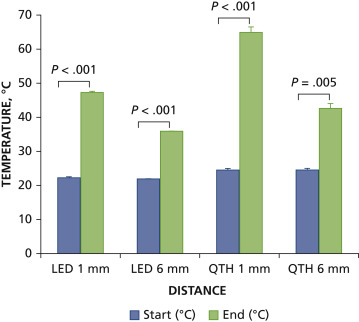Background
Light-emitting diode (LED) and quartz-tungsten-halogen (QTH) curing lights are used
commonly in clinics. The aim of this study was to assess the effect of these lights
on the proliferation of human gingival epithelial cells.
Methods
Smulow-Glickman (S-G) cells were exposed to a VALO LED (Ultradent) or an XL3000 QTH
(3M ESPE) light at 1 millimeter or 6 mm distance for 18, 39, 60, and 120 seconds.
Untreated and Triton X-100 treated cells were used as controls. At 24, 48, and 72
hours after light exposure, cell proliferation was evaluated via a 3-(4,5-dimethylthiazol-2-yl)-2,5-diphenyltetrazolium
bromide assay.
Results
The authors first evaluated the performances of these 2 lights. Both LED and QTH lights
generated heat. The LED light generated less heat than the QTH light and could save
approximately two-thirds of the curing time. When used for 18 seconds at a 6 mm distance,
the LED light did not inhibit the proliferation of S-G cells. However, if the exposure
time was longer (for example, 39, 60, or 120 seconds), the LED light inhibited cell
proliferation. The inhibitory effect increased when the exposure time was increased
to 39, 60, or 120 seconds. The QTH light did not inhibit S-G cell proliferation if
the exposure time was less than 120 seconds.
Conclusions
Prolonged exposure to a blue curing light (both LED and QTH) inhibits the proliferation
of gingival epithelial cells and may cause damages to oral soft tissues.
Practical Implications
In dental practices, a balance should be struck in consideration of curing time not
only to cure the composites completely but also to minimize unnecessarily prolonged
light exposure.


